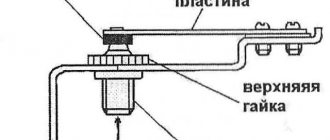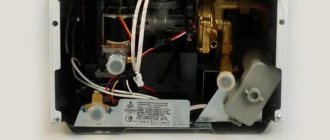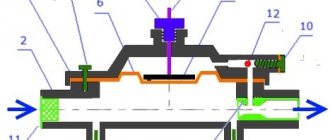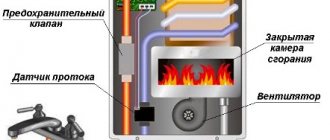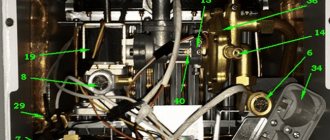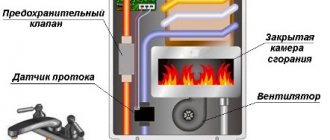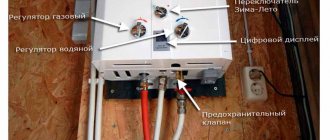The geyser is the “heart” of the water heating system of a private house or apartment. Maintaining this type of equipment requires certain knowledge and skills, right? You don’t know what batteries are needed for a gas water heater and how to replace them correctly?
We will help you sort out these issues - in the article we will look at the types of batteries used for the speaker and detailed instructions for replacement. We will also look at the reasons why they become unusable and how to choose new ones correctly. The publication is equipped with visual photos and videos, which will help solve a number of operational problems associated with the use, selection and replacement of power supplies.
Features of batteries for the speaker and nuances of choice
Modern speaker models rely on electricity to operate. The power supply, thanks to the spark produced, ignites the flame necessary to heat the water, and also guarantees the functioning of the display, which displays the current temperature and other information.
It is noteworthy that ignition in the very first gas water heaters was carried out manually using a rather dangerous method - using matches. Subsequent modifications of water heaters were equipped with a more ergonomic piezoelectric element , batteries or a hydrogenerator . There are also models of speakers with mains .
Nowadays, speakers with battery-powered ignition are in greatest demand. Analogue models with a hydrogenerator that replaces batteries are in much less demand. We have given the rating of the best geysers popular among buyers in this article.
The principle of operation of the hydrogenerator is quite simple: the flow of water rotates the blades, due to which an electrical impulse is produced
Significant disadvantages of columns with a hydrogen generator:
- the cost of such equipment exceeds the price of battery-powered speakers;
- the generator mechanism and blades are extremely sensitive and often suffer from poor water quality, and therefore require regular cleaning;
- The pressure in the water supply may not be sufficient to generate a strong spark.
Ignition of a battery-powered gas water heater is quite simple. So, in a column with an igniter, the process works like this: a small amount of gas is supplied to the igniter, and then, using an electrical pulse generated by batteries, it is ignited. The ionization sensor detects the presence of a flame and only after that gas is supplied to the main burner, where smooth ignition is carried out from the igniter.
In a direct-ignition column, gas is immediately supplied to the burner, which is ignited by an electrical impulse generated by the batteries.
Discharged batteries can lead to malfunctions in the heating equipment. Insufficient charge level provokes prolonged switching on or complete cessation of operation.
The need to replace the batteries in a geyser may be indicated by a popular “symptom” of incorrect operation of the equipment: the water heater starts idle several times in a row, making sounds characteristic of ignition. Some models are equipped with an indicator that indicates battery wear.
What batteries are used in the speakers?
For full operation, the gas water heater requires power sources with a total voltage of 3 volts. Therefore, batteries for water heaters stand out from the more familiar finger and mini-finger modifications. These are thicker “barrels” of class D , producing a voltage of 1.5 V each.
In fact, there are two types of batteries on the market: D-LR20 and D-R20 . They differ from each other in price and “filling”: inside the battery there may be salt or alkali.
D-R20 salt batteries are confidently losing ground, which is more of a plus than a minus. Cheaper power supplies are notorious for extremely fast discharge rates. Therefore, even the low attractive price does not make the purchase of the D-R20 worthwhile.
Alkaline alkaline batteries D-LR20 are more expensive, but do not require as frequent replacement, working properly for up to six months. A salt power source will last a couple of weeks at best.
To save as much money as possible on routine battery replacements, you should purchase rechargeable batteries. Used batteries and accumulators should not be disposed of with household waste, as power sources require special disposal.
Comparison of the appearance of batteries of different classes. Class D batteries look really impressive compared to power sources of other categories
Nickel-metal hydride battery versions - NiMH D/HR20 - are best suited for geysers. However, before installation, you should make sure that the voltage in each battery is 1.5 V.
If operating standards are observed, such batteries will last 5-6 years, gradually losing their capacity. But it is worth remembering that you will have to buy a battery charger separately.
Subtleties of choosing power supplies
The safest option to avoid making a mistake in choosing a product is to go to a store with old batteries and buy batteries with similar parameters.
When choosing, be sure to take into account the manufacturer’s recommendations and pay attention to the appearance of the product when purchasing it. However, this approach may not protect you from purchasing low-quality units.
Additionally, you should pay attention to the following nuances:
- compliance with the expiration date;
- packaging integrity;
- absence of abrasions and mechanical damage on the case;
- correct shape of the power source.
The abundance of counterfeits on the market and storage of products in inappropriate conditions without maintaining the correct temperature conditions significantly affect the service life of batteries and accumulators.
Power supplies purchased at the nearest crossing are unlikely to be certified and reliable products. Therefore, purchase batteries from official offline and online stores. After all, the use of any damaged battery is fraught with fires and damage to equipment.
What batteries are needed for a gas water heater?
The following types of products are suitable for installation in gas water heaters:
- D-LR20.
- D-R20.
The first type is an alkaline element. These batteries last for 5 – 6 months. The R20D is a conventional salt power source that will need to be changed quite often, because cheap products dry out very quickly. Both batteries have a voltage of 1.5 volts.
Alkaline batteries allow you to change the battery less frequently. But both batteries cannot be charged later. You can save money if you install a battery instead of a disposable power source.
Why do batteries lose their charge quickly?
If high-quality and expensive batteries or accumulators quickly lose their charge, it’s time to diagnose the geyser. There are a number of common reasons why batteries are suddenly thrown into the trash instead of working as expected. The following factors contribute to rapid wear and tear.
Reason #1 - excessive humidity in the room
Moisture and evaporation gradually settle on the parts of the gas water heater. Oxidative processes are started, which leads to corrosion of the contacts.
The main sign of such damage is the batteries becoming very hot during operation.
The photo shows batteries for the speaker. They oxidized and began to rust. If oxidation has already damaged the contacts, they need to be carefully cleaned
To prevent such a situation (oxidation of contacts), it is necessary to carefully consider the ventilation system in the room and regularly ventilate the room.
Reason #2 - incorrect operation of the ionization sensor
This sensor is responsible for the flame produced in the burner. If the sensor is physically moved to the side, it “does not see” the flame and gives a signal, and the solenoid valve stops the gas supply. Batteries need to supply energy over and over again to ignite. Therefore, it is worth checking the converter and correcting its position.
We provided more information about the flame sensor, its features and types, as well as other important gas equipment sensors in the following publication.
The sensor is also prone to contamination, because soot can settle on it. Cleansing will restore his sensitivity
Reason #3 - displacement of the ignition electrode
When the system starts and gas flows, a spark should be generated in a fraction of a second.
However, the ignition electrode may also deviate from its predetermined location in the structure. If ignition takes a relatively long time, it is worth moving the electrode closer to the burner.
The gap between the burner and the ignition electrode should be approximately 5 mm
Reason #4 - faulty control unit
An electronic module that is powered by batteries can also cause the problem of rapid battery discharge. Due to minor faults, the unit often spends more energy on its operation.
Therefore, it is worth inspecting the control unit for visual defects and burns after first disconnecting the wires leading to it
Some diagnostic measures can be carried out independently by turning off the gas and water supply.
But it is important to remember that a gas water heater is serious and quite dangerous equipment. Therefore, it is better to entrust repairs and preventive inspection of equipment to a professional technician. If there is a warranty, you should not open the case at all, as this may deprive the water heater of free service.
Reasons for rapid discharge
There are many reasons why even the best quality batteries are discharged very often:
- high level of humidity. If a gas heater is installed in a bathroom, then increased water evaporation can negatively affect its operation. Moisture settles on the contacts and promotes their oxidation, which leads to a decrease in charge,
- ionization sensor offset. Over time, the combustion sensor may become dislodged, causing it to take longer to produce a spark. In this case, much more energy is consumed, and charge loss occurs many times faster than it should,
- Piece displacement. The situation is similar to that described above. The pieze moves away from the burner and takes a longer time to ignite. In this case, in addition to the rapid discharge of electrical elements, there is also the possibility of an explosion as a result of gas accumulation inside the heater body,
- problems with the control unit board. In addition to the piezo, the speaker contains an electronic control module, which is also powered by batteries. If any problems occur on the unit’s board (burnt-out resistor, short circuit, dirty tracks, etc.), the charge is consumed faster than usual.
By eliminating the above problems, you will significantly extend the life of your batteries.
How to choose batteries
When choosing replacement batteries, you must follow the manufacturer's recommendations. In addition, it is advisable not to save money by purchasing cheap batteries. It is better to trust trusted manufacturers. In this case, the next replacement will not be required very soon. You can also buy batteries that are rechargeable. They cost more than regular batteries, but will last much longer.
Instructions for replacing old batteries
If you do not know how to properly change the batteries in a gas water heater so as not to damage anything, we recommend that you carefully read our instructions - then we will describe in detail the process of replacing batteries so that none of the users have any difficulties in performing this task.
The batteries are located in an easily accessible place, often at the bottom of the case, and can be easily removed.
In fact, the special battery compartment can have two types of configuration:
- retractable;
- on latches.
Pull-out boxes are opened by pressing on their wall.
In compartments that are closed with latches , batteries are often installed vertically. The batteries are held in place with a special latch, so they do not fall out of the box when opening the box.
Depending on the design features of the speaker, the batteries can be positioned vertically or horizontally, for example, in the “Neva” speaker model.
Replacing worn-out batteries in a gas water heater takes place in several successive stages:
- It is necessary to turn off the gas and water supply to the column.
- Carefully open the battery compartment by pressing on its side or bending the locking latches.
- Remove old batteries.
- Install new batteries, observing polarity.
- Return the box to its place (or close the lid). Correct installation is characterized by a characteristic click.
- Resume water and gas supply.
All that remains is to conduct a test run to ensure that the equipment operates correctly.
Timely replacement
Batteries do not discharge instantly, it happens gradually. With a gradual decrease in the charge of the batteries, the spark is produced unstably, as a result of which the burner does not ignite the first time, and you have to open and close the tap several times. If such symptoms appear, it is better to replace the batteries immediately, without waiting for them to be completely discharged.
It should be borne in mind that similar symptoms are also observed when the membrane wears out. Therefore, before replacing, you need to open the case and check the following:
- supply of gas and water,
- oxidation of contacts,
- rod movement.
Using a power supply instead of batteries
In order to significantly save money on replacing batteries and not spend money on buying expensive batteries, you can upgrade the gas water heater yourself. After installing the adapter for a household gas water heater, instead of batteries, the ignition will carry current from the network.
But this procedure has two disadvantages:
- in case of power failures, there will be no hot water;
- such “tuning” may deprive the right to free warranty service of the water heater.
If the owner does not have experience in connecting the power supply for a household gas water heater or other equipment, it is better to entrust this procedure to a professional.
When performing work, do not forget about aesthetics. Some homemade designs still look a little clumsy
To remake the column yourself, you will need an adapter that matches the parameters of the water heater. Since the batteries produce a total voltage of 3 V, you need a unit with a similar output voltage. The operating voltage in the network is 220 V, the adapter must have a similar input.
The marking of a suitable device will contain the following designations - 220V/3V/500 mA . Additionally, you need to buy female-male connectors.
To reconnect, you need to complete a number of steps:
- Gain access to the speaker power box and disconnect the wiring from it. For your own convenience, the connectors can be photographed or marked in any way, indicating their polarity.
- Cut off the plug from the purchased power supply, separate its wires and carefully solder them to the purchased connectors, observing the polarity. To determine the polarity, you can use a multimeter: positive readings of the device in voltage measurement mode indicate that the polarity of the wires matches.
- Connect the prepared wires to the column.
- Plug in the adapter and perform a test run of the instantaneous water heater.
If the connection is made correctly, the geyser will work properly, maintaining the required water temperature. After a test run, you can hide the wires in the housing.
To avoid malfunctions due to current fluctuations in the network, it is appropriate to add a stabilizer to the design. The device will protect the column from voltage surges.
What instead of batteries?
Topics not related to RADIO magazine are discussed
Return to Everything Else
Currently browsing this forum: no registered users and guests: 1
Posts: 5 • Page 1 of 1
What instead of batteries?
yug09 » 01 Feb 2009, 20:41
I bought a Beurer EM80 electromyostimulator. Everything is good, but 3 batteries run out very quickly. AA LR6. I have not found anywhere (and the manufacturer does not answer) which batteries are best to replace the batteries with. I wanted to adapt a power supply or phone charger, but I don’t know what current strength should be to replace three AA LR6 batteries. yug09 Messages: 3 Registered: 01 Feb 2009, 20:30
Re: What instead of batteries?
stas » 02 Feb 2009, 14:32
Why don’t batteries of this size (AA) work? If the batteries run out so quickly, the current consumption is high. All kinds of cell phone chargers are not designed for high current.stas Messages: 14 Registered: Sep 25, 2008, 06:26
Re: What instead of batteries?
yug09 » 02 Feb 2009, 19:21
Any AA batteries will fit instead of batteries, but the catch is that I heard that some LR6 batteries give too much discharge current, I'm afraid of burning the device, but in general, I would like to adapt a power supply to solve the problem forever. But nowhere can I find data on the current strength of AA batteries (LR6). I tried using weaker batteries, they just don't last.yug09 Messages: 3 Registered: 01 Feb 2009, 20:30
Re: What instead of batteries?
ASD » 02 Feb 2009, 21:11
yug09 wrote: ... some LR6 batteries give too much discharge current, I'm afraid of burning the device... No power source (be it a galvanic or rechargeable battery, or an AC adapter) can “give too much current” if its voltage is normal for the device it powers. Remember Ohm's law: I=U/R. Here R is the load resistance, in this case your stimulator, and U is the battery voltage. It's the trouble with tension. Three galvanic cells (of any size) are 1.5 x 3 = 4.5 V. And NiCd or NiMH batteries give 1.2 V each.
Is it possible to turn on the speaker without batteries?
I would like to answer this sensitive question in the negative, but, alas, in some models it is quite possible to carry out ignition yourself. The method is banal and incredibly dangerous.
So, if the model of the installed water heater does not have a special protection system, then you can unscrew the hot water mixer and bring a fireplace match to the burner in the column. The flame from the match will ignite the gas, the column will begin its work.
It is important that the ventilation system in the room with gas equipment is properly equipped, and the ventilation ducts should be regularly checked for draft
It is worth remembering that such treatment of the speaker can result in an explosion. Jokes with blue fuel often lead to death. Therefore, it is much safer to go to the nearest trusted store to buy batteries.
What batteries are needed?
The simplest alternative to batteries, as has already become clear, are rechargeable batteries. Their price will be slightly higher due to the fact that they last longer. You should also take into account the fact that you will also have to buy a charger for them. But after charging such batteries once, you can not change them for almost a year. It is also easy to power the speaker from a battery. The advantage of such an upgrade will be the absence of dependence on batteries. But the disadvantage will be dependence on the electrical grid - if the electricity disappears, then there will be no water either. If you follow the steps correctly, then in such a situation it is easy to switch to batteries.
If you do not know how to do this, then the principle of the work to be done will be as follows. As you know, 2 batteries produce a voltage of three volts and are located in a special compartment. In order for the analogue to be adequate, it is necessary to buy a power supply with the following features: the input must be 220 volts, and the output must be three volts. The current strength should be five hundred milliamps. On the market you need to purchase two connectors, which are called “male-male”.
Remove the cover from the speaker and disconnect the cable from the battery compartment. As a rule, the wires are of different colors, where blue will be negative and red will be positive. If the cables have the same color, then you should look in the battery compartment for their polarity and make the appropriate marks with a felt-tip pen. We tear off the plug from the power supply and use a soldering iron to connect the connectors to the cables. Now you need to use a multimeter to determine the polarity. The mode should be set to change voltage. If the value is "+", then the polarity of the wires will correspond to the probe polarity. It is necessary to connect the cables of the speakers and the power supply. It is better to disconnect the power supply at night.
Modern versions of geysers have sensors and fuses that, in the event of a breakdown, can turn off the device and inform about the presence of a breakdown.
It should be noted that using a power supply for geysers instead of batteries will have two important advantages:
- no need for regular costs for purchasing batteries;
- stable operation of this element.
At the same time, there are certain disadvantages. For example, after such a conversion, the manufacturer will refuse to provide warranty service for the device. And as already noted, such speakers become too energy dependent. Moreover, if there is a voltage drop in the electrical network, the column may simply burn out.
The reason for the rapid discharge of batteries in a gas water heater
The battery runs out quickly due to low capacity or poor quality. Chinese D-type batteries can last 2-3 weeks at most.
Main reasons:
- There is a malfunction in the control unit.
- Increased air humidity.
- Bad batteries.
- Deviation of the electrode responsible for ignition to the side.
- The ionization sensor is damaged.
High moisture may occur if the column is installed in the bathroom. Condensation settles on the parts and prevents the spark from passing through normally. Next comes the oxidation of the contacts and the corrosion process starts.
To avoid all this, it is necessary to clean, ventilate the room and install a reliable ventilation system. It is recommended to ventilate the room as often as possible.
When the ionization sensor does not start correctly, there may be no fire in the burners. A strong shift in its direction will lead to a long spark formation and high energy consumption. To fix this, just fix the sensor. Sometimes it gets clogged due to soot. When the gas flows, it should instantly ignite from a spark. If this does not happen, try pulling the electrode closer to the burner. This action should help.
If the control panel is damaged, it may require more electrical power to operate. To fix this problem, simply remove the cover and carefully inspect the unit. Then we disconnect the wires that go to it. After opening, inspect the wires for any burns. If everything is in order, then you should contact a specialist.
Power supply for geyser - batteries and power supply
Automatic instantaneous boilers using gas have a main burner ignition system, which requires electricity to operate. Power is supplied in several ways. The power supply and batteries for the gas water heater are used in most models of water heaters. Less commonly you can find equipment that uses a hydrogen generator to produce a spark.
The role of batteries in the column
Ignition in the first instantaneous water heaters was carried out using matches. The next generation of equipment began to use a piezoelectric element that ignites the wick, which in turn is used to ignite the main burner.
There is no igniter in automatic dispensers. When ignited, a spark is produced and supplied directly to the main burner device. The power source is batteries installed inside the case.
Gas water heaters with a hydrogenerator are expensive, sensitive to pressure changes in the pipeline and water quality, so they have not yet become widespread and have not earned popularity among domestic consumers.
About 80% of all water heaters sold are battery operated. There are special adapters that allow you to connect the boiler to a regular household network.
The principle of operation of a battery-powered speaker
The need for electricity for automatic gas boilers is associated with several main functions and tasks:
- producing a spark;
- operation of the LED display displaying the water heating temperature.
The principle of operation of battery-powered geysers is as follows: when the hot water tap is opened, water enters the reducer. The created pressure moves the rod, which opens the gas supply and at the same time sends a signal to the ignition unit and turns on the display.
The batteries in the geyser serve as a source of energy. Over time, the elements shrink, which leads to malfunctions: prolonged switching on and failure to operate.
How long do the batteries last in the speaker?
It all depends on the serviceability of the water heater and the correct settings. Geysers with automatic ignition from batteries can operate without the need to replace power sources for about 6 months. Of course, this is only possible if high-quality elements are used.
If the batteries run out quickly, the problem most likely lies in a faulty ignition unit, or in the spark-producing electrodes located in the wrong position.
In addition to what is described, the following can lead to rapid battery discharge:
- increased humidity in the room;
- contamination of the bypass and sticking of the solenoid valve;
- oxidation of electrical contacts (characteristic sign: batteries become very hot);
- clogging of the main burner jets.
The frequency of battery replacement is also related to how often the water heater is turned on. If the boiler is used only for showering, the power will last for at least 4-8 months. If the tap is opened constantly, “pulling” the column, even when there is no need for hot water supply, the power supply elements will run out in 1-2 months.
You can tell that the battery is dead by several characteristic signs:
- the intensity of spark production decreased;
- LED display does not light up;
- the column turns on the second time or completely refuses to work.
When installing inexpensive batteries, you should not expect them to work for a long time. Cheap batteries will last no more than 2-3 months.
What batteries are needed for a gas water heater?
Owners of instantaneous gas water heating equipment will have to periodically face the need to replace batteries. Experience shows that choosing the right battery type reduces costs. In addition, the battery life of the speakers increases.
There are several types of batteries:
- Alkaline batteries (LR20 D) are traditional batteries. They are characterized by low cost. The size of the battery is a large “barrel” type D. When purchasing, you should pay attention to the quality of the product. The service life of a battery directly depends on its cost. The cell is single-charged, the average service life is 6 months.
- Batteries for geysers (NiMH HR20/D) - the main advantage: the ability to reuse the elements after additional recharging. Charger sold separately. Nickel-metal hydride batteries are suitable for speakers. The total service life, subject to proper operation, is 5-6 years without the need for replacement.
| Alkaline batteries | |||||||||
| Type/IEC | ANSI/NEDA No. | DURACELL | EVEREADY | KODAK | PANASONIC | RAYOVAC | TOSHIBA | VARTA | Other |
| LR03 | 24A (AAA/MICRO) | MN2400 | E92 | K3A | AM4 | 824 | LR03N | 4003 | |
| LR6 | 15A (AA/MIGNON) | MN1500 | E91 | KAA | AM3 | 815 | LR6N | 4006 | BA3058/U |
| LR14 | 14A (C/BABY) | MN1400 | E93 | KC | AM2 | 814 | LR14N | 4014 | BA3042/U |
| LR20 | 13A (D/MONO) | MN1300 | E95 | KD | AM1 | 813 | LR20N | 4020 | BA3030/U |
| 6LR61 | 1604A (9V/BLOCK) | MN1604 | 522 | K9V | 6AM6A | 1604 | 6LF22 | 4022 | BA3090/U |
| Batteries | |||||||||
| Type | EVEREADY | NEDA | Other | ||||||
| NiMH-AAA (MICRO) | NH12 | 1.2H1 | HR03 | ||||||
| NiMH-AA (MIGNON) | NH15 | 1.2H2 | HR6 | ||||||
| NiMH-C (BABY) | NH35 | 1.2H3 | HR14 | ||||||
| NiMH-D (MONO) | NH50 | 1.2H4 | HR20 |
| Battery designations | ||||||
| American title | Name GOST | Common name | ||||
| 1. | A (A23) | — | — | |||
| 2. | A.A. | Element 316 | AA battery or two A battery | |||
| 3. | AAA | Element 286 | pinky battery or three A battery | |||
| 4. | AAAA | — | "four A" | |||
| 5. | C | Element 343 | C – battery, “inch”, “eska” | |||
| 6. | D | Element 373 | D – battery, large, “barrel” | |||
| 7. | — | Element 3336 | "square", "flat" | |||
| 8. | PP3 | Crown | "crown" | |||
| Dimensions, capacity and markings of batteries | ||||||
| Dimensions, mm | Voltage, V | Nominal capacity*, Ah | Battery markings from various companies | |||
| GOST | IEC | Varta | Other | |||
| 33x60.3 | 1,5 | 14,3 | A373 | LR20 | 4920 | D, XL |
| 25.4x49.5 | 1,5 | 8,0 | A343 | LR14 | 4914 | C, L |
| 14.5x50.5 | 1,5 | 3,1 | A316 | LR6 | 4906 | AA, M |
| 10.5x44.5 | 1,5 | 1,35 | A286 | LR03 | 4903 | AAA, S |
| 25.5x16.5x47.5 | 9,0 | 0,6 | Corundum | 6LR61 | 4922 | E, 9V |
The choice of batteries is also determined by their cost. Standard lithium cells will cost 80-100 rubles/piece. Batteries will cost at least 300-500 rubles/piece.
How to change batteries in a speaker
In instantaneous gas boilers, a special place is provided for batteries. Usually this is a plastic container located at the bottom of the case. There is a hinged lid with a locking lock. The batteries should be inserted into the speaker after it is turned off.
To this end:
- open the lid;
- carefully pull out the barrels, slightly bending the plastic clips;
- install new batteries, observing +/- polarity;
- close the lid and do a test run.
To extend the life of the batteries, if you do not plan to use the speaker, you can turn it off using a special switch at the bottom of the case. The button disconnects the ignition unit from the batteries.
How to light a gas water heater without batteries
This method should be used with extreme caution. If the batteries suddenly run out and you need to: take a shower, wash the dishes, etc.
, you can do the following:
- open the hot water tap;
- bring the fireplace match to the main burner.
If special additional protection is not installed in the water heater, this should work, the column will start and work. For safety reasons, it is better not to do this!
Power supply for geyser instead of batteries
A popular solution for its low one-time investment and the ability to completely eliminate the need for separate batteries. You can replace the batteries in geysers with a power supply or an adapter. The essence of the device is simple.
Electricity is taken from a household outlet, converted into a constant voltage of the required power and then supplied to the ignition unit.
The power supply for geysers has several advantages:
- there is no need to regularly spend money on batteries;
- The ignition unit works stably.
Replacing batteries with a power supply has some disadvantages.
The manufacturer will refuse warranty claims after such conversion. Speakers with an adapter become energy dependent. There have been cases when, due to a strong power surge in the network, the electronic circuit boards of the speaker burned out.
How to convert a speaker from batteries to a power supply
There are adapters made in the factory. They are easy to install thanks to the included instructions. You can make a homemade power supply.
For this:
- buy a power supply with parameters 220V / 3V / 500 mA, two contact connectors (female/male);
- the wires from the battery compartment are routed downwards;
- connected by soldering, taking into account polarity, with the taps from the adapter (indicated in the power supply diagram);
- a test run is in progress.
A power supply is a good alternative to batteries, only in cases where the conversion is done by a person who understands the basic operation of the speaker, and also if for some reason there is no need for warranty service.
Source: https://AvtonomnoeTeplo.ru/vodonagrevateli/750-blok-pitaniya-i-batareyki-dlya-gazovoy-kolonki.html
